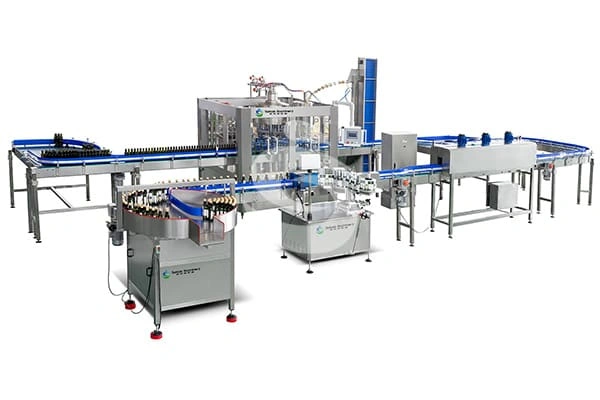Common Issues in Beverage Bottling Lines and How to Fix Them
Table of Contents
-
Introduction
-
Understanding Beverage Bottling Lines
-
Common Issues in Beverage Bottling Lines
-
Troubleshooting and Fixing Methods
-
Preventive Maintenance Tips
-
Why Choose Reliable Beverage Filling Equipment
-
Conclusion
-
Q&A Section

1. Introduction
Running a modern beverage bottling line can be a complex task, especially when every minute of downtime costs money. Whether you’re producing CSD beverages, juice, or water, small issues can quickly snowball into major production delays. But don’t worry—most of these problems are preventable with the right beverage filling equipment and a few smart maintenance habits.
2. Understanding Beverage Bottling Lines
A complete beverage bottling line typically includes rinsing, filling, capping, labeling, and packaging systems—all working in harmony. When one part fails, it can affect the entire production flow.
These lines are often used for CSD beverages (carbonated soft drinks), water, tea, energy drinks, and other liquid products. High-quality beverage filling machines ensure accurate volume, consistent carbonation levels, and perfect hygiene—key factors for any brand’s reputation.
3. Common Issues in Beverage Bottling Lines
| Problem | Possible Cause | Impact on Production |
|---|---|---|
| Inconsistent Fill Levels | Air pressure fluctuation or faulty valves | Wasted product, brand inconsistency |
| Bottle Jamming | Misaligned conveyors or bottle shape variation | Downtime, damaged bottles |
| Foaming in CSD Beverages | Incorrect CO₂ pressure or temperature | Labeling delays, product loss |
| Cap Misalignment | Worn capping heads or improper torque | Leakage, customer complaints |
| Label Wrinkling | Incorrect tension or humidity | Poor product appearance |
4. Troubleshooting and Fixing Methods
✅ Inconsistent Fill Levels:
Check the air and liquid pressure balance. For beverage filling machines, ensure that the filling nozzles are calibrated and cleaned regularly.
✅ Bottle Jamming:
Inspect the conveyor belts and star wheels for alignment. Also, use sensors to detect irregular bottles early in the line.
✅ Foaming in CSD Beverages:
Temperature control is critical. Keep the product cool before filling, and make sure your CO₂ levels are stable. Modern beverage filling equipment often includes pre-chilling systems to reduce foam.
✅ Cap Misalignment:
Replace worn-out capping heads and verify the torque setting. Automatic capping systems with torque sensors can prevent most of these issues.
✅ Label Wrinkling:
Use humidity-controlled environments and ensure the label applicator is properly tensioned. Regularly inspect your label rolls for damage.
5. Preventive Maintenance Tips
Regular maintenance is the simplest way to avoid downtime in beverage bottling lines. Here’s a quick checklist:
-
Clean and sanitize all parts daily to prevent contamination.
-
Calibrate flow meters and pressure valves weekly.
-
Replace seals and O-rings every 3–6 months.
-
Lubricate moving parts as per the manufacturer’s manual.
-
Train operators to detect and report minor irregularities early.
6. Why Choose Reliable Beverage Filling Equipment
Here’s where things really make a difference. Investing in high-quality beverage filling machines from a trusted manufacturer isn’t just about buying hardware—it’s about securing efficiency, consistency, and peace of mind.
A professional supplier provides:
-
Custom line solutions for different bottle sizes and CSD beverages.
-
One-stop service including installation, training, and after-sales support.
-
Advanced automation for reduced labor and higher accuracy.
-
Strong technical background ensuring long-term reliability.
Well-designed beverage bottling line is not an expense—it’s an investment in sustainable growth.
7. Conclusion
Every production line faces challenges—but most are solvable with the right approach. By choosing durable beverage filling equipment, following a proper maintenance schedule, and partnering with an experienced manufacturer, you can ensure smoother operations, fewer breakdowns, and a consistently high-quality output for your CSD beverages and beyond.
8. Q&A Section
Q1: How often should I service my beverage filling machine?
A: For optimal performance, basic cleaning should be daily, with full maintenance checks every 3–6 months.
Q2: Why do my CSD beverages lose carbonation after filling?
A: The product or bottle may be too warm. Pre-chilling your beverage before filling usually solves this.
Q3: How can I increase efficiency in beverage bottling lines?
A: Invest in automated systems, monitor key performance indicators, and choose high-quality beverage filling equipment with precise control systems.
Q4: What’s the most common cause of bottle jams?
A: Usually it’s misalignment in conveyors or improper bottle feeding. Regular calibration keeps things running smoothly.

